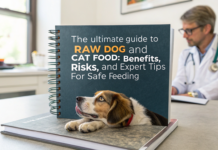Last Updated on September 5, 2024 by Dogs Vets
Dog food has come a long way from your garden variety of chicken or beef. Now, it’s all about dry, canned, semi-moist, homemade or organic. The mind boggles.
It can be confusing to stand in the pet food aisle and not know where to start, especially if you’re a first-time pet parent. Hopefully, this article will give you a better understanding of how to choose the right dog food for your fur kid.
#1. AAFCO Guidelines
The Association of American Feed Control Officials (AAFCO) is a non-profit organization that regulates the sale and distribution of animal feeds. This includes pet food.
Dog food manufacturers in the U.S. have to abide by specific guidelines set out by the AAFCO. Pet food approved by the organization should contain the following on the label:
- Nutritional adequacy statement
- Guaranteed analysis
- Ingredients list
PetMD says most dog food labels are mostly made up of marketing. The two sections to concentrate on are the ingredients list and the guaranteed analysis. The latter describes minimum and maximum amounts of important nutrients. Protein should have the highest percentage. The AAFCO recommends minimal levels of 22.5% for puppy food and 18% for adult dog food.
#2. Important Ingredients
Good quality dog food must have three main nutrients to ensure your pup has a healthy, balanced diet. Animal protein is the main source and can come in the form of meat, chicken, beef, fish or turkey. Natural carbohydrates and healthy fats are as important in your pooch’s diet.
Dietary fiber is an often overlooked nutrient. They regulate the digestive system and help maintain blood sugar levels. Pet food experts do advise staying away from ingredients lacking definitions like “by-products”, “artificial additives”, “generic fats and proteins”.
#3. Store-Bought Dog Food
Commercial pet food takes the guesswork out of trying to figure out the right amount of nutrients your doggy needs. It’s convenient and takes less or no time to prepare.
Brands are taking on the sustainable mantle and embracing ethical practices in sourcing their ingredients. Consciously sourced pet food is mainly humanely raised beef, free-range and antibiotic-free. And it’s not just wet food. Previously, kibble and other dry dog food were deemed an inferior alternative to their canned counterparts. Now brands are making their dry dog foods nutrient-rich, packed with protein and yummy flavor.
Probably the biggest advantage of store-bought dog food is peace of mind. Veterinary nutritionists are employed to develop recipes to meet your pet’s dietary needs, based on age and breed. River Road Animal Hospital says if the food label contains “complete and balanced,” it meets AAFCO requirements.
To ensure your pet food is sustainably sourced, Open Farm suggests checking for the Certified Humane label to ensure suppliers are practicing responsible farming techniques.
#4. Homemade Dog Food
As the popularity of pet cafes and dog restaurants grows, so too are pet parents pulling out all the stops and creating gourmet-style dishes for their pups. Like cooking a meal from scratch, it can be time-consuming. Getting the ingredients just right requires some concentration. Thankfully, the internet is a great source of inspiration for recipes and dog treats.
But not all veterinary nutritionists are on the same page when it comes to homemade dog food. The American Kennel Club (AKC) advises pet parents to err on the side of caution and warns that many recipes are not reviewed by experts in providing a nutritional, well-balanced diet.
Pet owners should take their dog’s age, size and health into account. It is recommended not to feed your puppy homemade dog food if they’re less than a year old or pregnant.
#5. Dog Allergies
You may not even know your pooch has an allergy until it starts to flare up. Some dog food contains fillers such as wheat and soy. Additives and food dyes can play havoc with their systems. If your pup does have allergies and you’re stuck on how to supplement their diet, always consult your veterinarian. They will be able to devise a course of action to ensure your fur baby gets the most nutrition.
Stay away from food that contains too many preservatives, soy, wheat and corn. The AKC says to avoid animal byproducts and artificial flavors. Ensure their diet is as close to natural as possible. You wouldn’t eat ingredients that you don’t recognize, so why feed them to your pets? Just like your dog continues to grow, so too do their nutritional needs. Make sure they’re on the correct stage of dog food and take them for regular checkups.

















